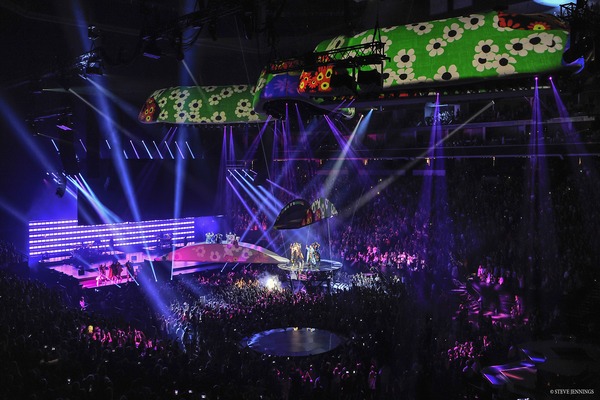Lady Gaga kicked off her headlining concert tour Joanne in Vancouver, Canada in August 2017, alongside 5 d3 4x4pro media servers.
Production Designer LeRoy Bennett designed the 85ft wide main stage with 3 automated lifts used for scenic props and staging equipment. Five performer wave lifts, faced with LED video panels were designed to shape-shift into different configurations; flat, elevated, criss-cross, diagonal and staircase, with content seamlessly tracking the various configurations powered by d3 Technologies.
Overhead, 3 inflatable lighting pods, designed and manufactured by TAIT Towers, stretched across the venue, each with an articulated bridge that unfolded into an oval projection surface. The bridges landed on 2 raised, automated platforms, creating a path over the audience and connecting the A stage to the B stage, clad in dichroic plexiglass and featuring a geometric piano filled with lasers.
A total of 5 d3 4x4pros, 3 DVI VFC cards, 3G-SDI input, timecode and Art-Net control are deployed for the show. d3 Technologies was chosen for the tour because the creative team “needed to be able to previsualise and model the articulated movement of the bridges and lifts,” explained Loren Barton, Media Department Head and Programmer with Lumentech Inc. “The VFC cards allowed us to minimise the number of machines required to playback the content to the 28 projectors and LED outputs. d3 also allowed us to mockup, test and troubleshoot the automation system within the 3D space, which was incredibly helpful since we had limited time in the space with the actual set,” said Barton.
“Using d3 to previsualise the production was key to evaluating which lenses we would need and which angles would work to hit all of the surfaces in this design,” he notes. “The many mapping options to program the show also allowed us to look at ideas and projector locations quickly without having to re-render content to see if an effect would work.” Specifically, “using UDP feedback from the TAIT’s Navigator automation system we had to design and implement a solution to project onto the morphing objects with minimal calibration time. Ben Keightley, d3 System Designer and Programmer, used a 3-part model for each bridge and developed formulas to mimic the motion of the folding and unfolding to make sure the projections in our models stayed locked to the objects in reality.”
d3 boasts a number of features that are proving indispensable to the tour. “I always use SockPuppet DMX interface because of the importance of locking video programming to lighting control,” Barton continued. “We use Art-Net control for sequencing because of how easy it is to edit and follow the programming that lighting is doing. When song edits happen, we can simply edit one timecode pool on the grandMA2 and not dig into timelines on the d3.”
Andreanne Lafrance, the d3 Technologies and Projectionist from Solotech, and Pascale Boileau, Projectionist from Solotech, “do an incredible job every day making sure the show looks perfect every night,” stated Barton. “Arenas change size and shape, and the alignment has to be done in each location to ensure projections follow the set. d3 streamlines this process and provides the tools to make sure the warps and blends create a seamless canvas. QuickCal and warping are essential given the limited time the projectionists have to get the show aligned and calibrated. The QuickCal process has to take less than 2 hours since the show loads in with minimal pre-rig time.”
“As with many shows we had a tremendous amount of media to ingest and process with limited programming and rehearsal time, d3 rose to the challenge and delivered wonderful results and an excellent workflow,” concluded Barton.






